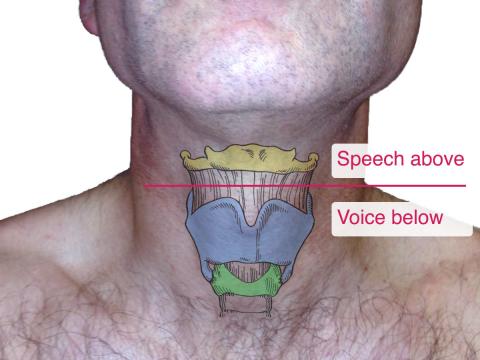Aren’t voice and speech the same thing? While they are related, they are not the same and speech problems and voice problems can be easily confused.
An easy mental image we can use to separate speech from voice is to draw a line, which we will call the “Speech Line,” across the neck above the Adam’s apple. This Speech Line roughly separates speech production above from voice production below. The two systems interact and to some degree overlap. Yet in general, below the Speech Line, sound is created, above the Speech Line, sound is modified into language.
Below the Speech Line, the larynx produces audible vibrations – sound – in the normal human system. Above the Speech Line, sound is modified. More specifically, vowels are the modification of the resonance cavities (mostly the pharynx and tongue modify the shape of the resonating cavities) and consonants are the interruptions or restrictions of the airflow. The interrupters include the palate, the tongue and the lips. These alterations in the airflow, when combined, coalesce to form words, then phrases, then sentences and we begin to communicate. We achieve speech.
If the problem is with difficulty producing words clearly, the issue is most likely in the upper half of this system. A physician would call this dysarthria. This problem is not with sound production because volume is good, and any single sound is quite clear on its own. When one looks at the vocal cords, they will be vibrating well.
Focusing an examination above the Speech Line: on the face, difficulty moving lips may be noted; in the mouth may be difficulty controlling the movement of the tongue; at the back of the nose and mouth, the palate may not elevate completely. These motion impairments can garble speech. In adults, most new problems with speech are neurologic problems.
A few impairments to speech are caused by an interruption of airflow right at the level of the vocal cords. Completely interrupting the production of sound ends up impairing speech since without sound, movements of the tongue and lips are not heard. Speech is completely dependent on having a voice so with no voice, there is no speech.
On the other hand you can use a voice without speaking. For example, you can sing without word production. A sound can be generated which is entirely musical in quality and carries no significant cognitive information even though it may carry a great deal of emotional information. A baby’s cry is mostly pure sound, carrying some very basic information – and most of that information is emotional and the meaning must be inferred.
We can imagine speech (at an unvarying pitch and volume) as a package of cognitive information. Voice is primarily used for the transmission of speech and adding emotional information. Voice then typically carries information from one location to another. With voice, we increase volume or change pitch to carry our words out to a distance or through background noise. We also alter our volume and pitch to transmit emotion.
Problems above the Speech Line are not voice problems.

